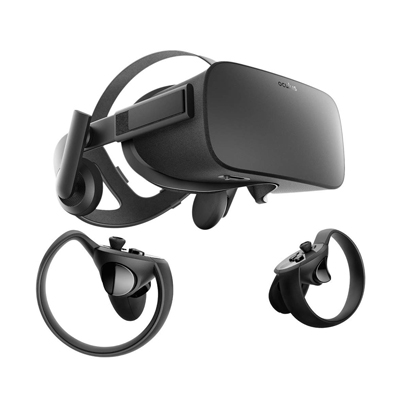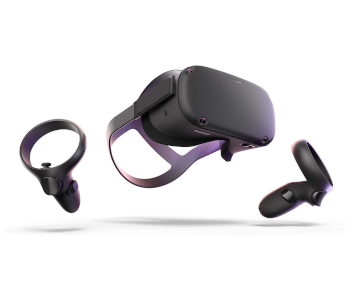Oculus Rift S vs. Oculus Quest: Which VR Headset Should You Get?
The Oculus brand is virtually synonymous with VR. After all, they were the pioneers of consumer-grade VR headsets, providing the foundation of what is now a thriving industry of devices used to augment the entertainment experience.
While Oculus remains the number one brand that is purely dedicated to VR headsets, their line of offerings has greatly expanded from their humble beginnings. In this article, we shine the spotlight on two of their most popular: the Oculus Rift S and the Oculus Quest. How are they different? Is one better than the other? Which one should you get?
Design and comfort
In terms of the overall look, the Oculus Quest retains most of the design elements of the older Oculus Rift CV1 model. It’s secured to your head with a headband with Velcro adjustments on either side and a top strap that can also be adjusted to keep it snug. While this is the way that VR headsets have always been designed in the past, it also fails to address the usual issues with comfort – namely, that the design presses the VR headset against your face.
The Oculus Quest might take a little getting used to, but we can’t help but feel disappointed that they missed the chance to re-design the typical VR headset to enhance its comfort.
The Oculus Rift S benefits from the revamped design of the Lenovo VR headsets. Instead of a band that wraps around your head, the Oculus Rift S is supported by a halo that sits at the top of your head and can be adjusted with a simple dial. This design is so much more comfortable, as you don’t end up feeling the pressure of the straps against your face.
Performance hardware

Let’s get the most obvious difference between the two models out of the way first. The Oculus Rift S inherits a lot of the DNA of the original Oculus Rift. This includes the fact that it needs to be tethered to a gaming PC or any type of workstation. This means that it does not come with its own graphics card or GPU – instead, it will rely on that of your PC.
The good news is that the recommended PC specs for the Oculus Rif S aren’t intimidating as it only uses the same core software as the slightly older Oculus Rift CV1. If your PC is equipped with an AMD Radeon RX 480 or an NVIDIA GeForce GTX 1060, then you’re good to go and you’ll be using the Oculus Rift S at its maximum capability.
In contrast, the Oculus Quest is a fully self-contained VR headset. Aside from making the Quest much more portable, this feature alone makes it viable for users who do not own VR-ready workstations. Since it works without being tethered to a PC, all of its hardware has been integrated into the headset. While the included Snapdragon 835 processor makes it possible to use the Oculus Quest on the go, it is still severely under-powered compared to the hardware of a typical gaming PC.
Graphics performance and display
The graphics performance of the Oculus Rift S is hard to define because it depends on how souped-up your gaming PC is. As we’ve mentioned, you don’t need the very best graphics card to get started using this VR headset. If you choose to get a Rift S, then you will always have room to upgrade the graphics performance of your VR experience.
The display of the Oculus Rift S has a combined resolution of 2560 x 1440, which is slightly lower than the Quest. What the Rift S has is a slightly higher 80 Hz refresh rate, which may perfectly complement a powerful GPU in your gaming machine. However, the choice to use an LCD display for the Oculus Rift S feels like a downgrade from the OLED display of the Rift CV1.
One of the biggest disadvantages of a standalone VR headset like the Oculus Quest is that there’s a set ceiling on its graphical capabilities. While its Snapdragon 835 processor is surely a tangible upgrade to the Oculus Go’s Snapdragon 821, it still cannot hold a candle to a high-quality PC graphics card.
The good news is that the Oculus Quest sports a 2880 x 1600 resolution OLED display, which helps amp up those deep blacks and bright whites. Its refresh rate is a modest 72 Hz, which is probably fine in the context of its limited graphical processing power.
Audio
Both the Oculus Quest and Oculus Rift S have integrated audio. This means that you no longer need to plug in an external headset or earbuds, unlike the previous generations of Oculus VR headsets. While it’s nice to not have to use an external accessory for audio, it also means that you become a little more receptive to sounds from your environment.
Fortunately, both VR headsets still have 3.5-mm. jacks if you want to use third-party headphones for better immersion.
Tracking and controls

Both headsets come with the updated Touch Controllers, which boast of improved responsiveness, tracking, and have more ergonomically mapped buttons. In terms of design, the new controllers don’t look all the different from the previous generation. This is a good thing, though – the old Touch Controllers were already close to perfect. Aside from being lighter and a slight repositioning of the tracker rings, these controllers don’t look radically different.
Both the Oculus Rift S and the Oculus Quest support six degrees of freedom (6DOF) motion tracking. The six degrees refer to the three measurements of position (X, Y, and Z axes) and the three axes of rotation (pitch, yaw, roll). This means that these headsets don’t just track the direction where you’re facing, but also your position in three-dimensional space.
Both headsets also come with the Guardian tracking system that sets the boundaries of your play area, for the safety of both yourself and the people around you. You can do this by simply “painting” how far you want the boundaries of your play area to be using the controllers.
The sole difference between the two headsets is the number of sensors they use for tracking. The Oculus Quest has four trackers – one on each corner. The Rift S does this one better with five sensors that are positioned very differently – one at the top, two at the front, and two on the sides.
The tracking performance of the Quest is already excellent, so there may not be a lot of times when the difference in tracking between the two models can be apparent. Still, the superiority of the five-sensor tracking is undeniable and can come in handy in VR games where perfect tracking is needed.
Content library
The Oculus Rift S has a huge advantage in the content department since it gives you access to the PC-based Oculus store. This online content library has been around since the first Oculus Rift and has literally thousands of games and other VR experiences. The Rift S also gives you access to the SteamVR platform where you can play VR-enhanced game mods made by a community of immensely talented PC modders.
The Oculus Quest relies on an Android-based library which is certainly not bad but pales in comparison to the PC-based Oculus store. This is another consequence of the less powerful hardware housed inside the Oculus Quest.
You can still access a couple of excellent titles, such as the action-packed SuperhotVR and the ever-popular Beat Saber, so it’s not an immense loss. The Oculus Android store has about several dozen titles which you may want to check out before committing to one model or the other.
Adaptability
The interpupillary distance (IPD) of a VR headset refers to the distance between its two displays in the context of the location of the pupils of the user’s eyes. For old VR headsets, this used to be a fixed value, determined by what is “normal” or most common among people.
Modern VR headsets have adopted a simple slider that allows you to set the headset’s IPD to whichever feels best for you. This is the same setup found in the Oculus Quest, which is great despite its simplicity. The Oculus Rift S opts for a more software-aided solution. While sophisticated, we find that it is still harder to get the perfect view with the Oculus Rift S if the original IPD setting isn’t compatible with your eyes.
Price
This is what makes these two VR headsets excellent for side-by-side comparison. Both the Oculus Rift S and the Oculus Quest retail for about $399. This is the price point for a 64 GB version of the Oculus Quest, but there is also a 128 GB version which is costs about $100 higher.
Which one should you get?
With similar price tags, picking one model over the other is simply a matter of knowing your priorities. Both these headsets are excellent products and are great examples of the level of quality we have come to expect from one of the oldest brands in the VR headset business.
If you’re still torn between picking the Oculus Quest over the Rift S (or vice-versa), then these are the factors that you should be considering.
1. Wireless freedom
The main selling point of the Oculus Quest is that it gives you a truly wireless VR experience. You don’t need to connect it to a PC or even use it with an external accessory such as a smartphone or a third-party headset. Every piece of hardware is self-contained. Aside from the convenience of not having a wire hanging down your shoulder while you play your VR games, this also means that you can bring your Oculus Quest with you wherever you go.
While the tether of the Oculus Rift S is now five meters long (one meter longer than that of the Rift CV1), the mere fact that it’s there can be a frustrating experience. Oculus offers the option of an even longer cable for the Rift S for an additional cost, which you could explore if you feel that a wired experience is acceptable if you can get a bit more leeway.
What it comes down to is if you can tolerate wearing a VR headset that is tethered to your workstation or gaming PC. If not, then the Oculus Quest is obviously the way to go.
2. Do you have a VR-ready PC?
Getting an Oculus Rift S is pointless if you don’t already have a gaming PC or have no intention of getting one. Since it has no graphical processor of its own, it will rely on the GPU of your PC. The Oculus Rift S isn’t so discriminating on its GPU requirements, though, so you likely won’t need to spend a fortune.
That aside, the Oculus Rift S is not a standalone VR entertainment system. If you do already have a gaming PC with good specs, then you can consider the Rift S as an excellent accessory that opens up a whole new world of gaming.
If you’re just planning to build a gaming PC, then you’ll need to be prepared to spend somewhere between $1000 to $2000. While it’s certainly not cheap, there are a lot of very good reasons for why PC gaming has endured in an era when there are some truly excellent gaming consoles in the market.
3. Content availability
The graphical processing power that the Oculus Rift S accesses when it tethers to your PC makes it compatible with a much wider market of VR games in the Oculus store. There are thousands of them right now, and while some of them have questionable quality, you’re not bound to ever run out of content for your Rift S.
On the other hand, the limited graphics processor that comes built-in with the Oculus Quest also limits the VR games that it can handle. For this reason, Oculus has a dedicated Android store for the Quest. The selection isn’t bad, and there are still a lot of excellent titles in there, but the number of games is magnitudes lower than the PC-based Oculus store.
4. Comfort
The Oculus Rift S benefits from the revamped design aesthetic carried over from the Lenovo headsets, which makes it so much more comfortable for long sessions of gaming. If you’re tired of VR headsets hurting your face within an hour, then the Oculus Rift S is going to be a refreshing change.
However, the lack of a manual IPD adjustment in the Rift S really hurts its comfort rating. After all, there’s no point in a VR headset that fits comfortably but doesn’t adopt the physical characteristics of the user. If you’re going for the Oculus Rift S for the sake of comfort, we recommend taking it out for a spin first to check if its default IPD setting is good enough for you.
Final thoughts
Despite all the competitors popping up, Oculus remains a strong brand in the VR headset market. Their latest offerings, the Oculus Quest and the Oculus Rift S, are excellent additions to their stellar range of offerings. Each of these two headsets offers a different but uniquely high-quality VR experience to any type of gamer.
Both headsets have excellent hardware, performance, and come with the premium Oculus Touch controllers. Choosing one over the other is a question of how you intend to use the VR headset: are you looking for a headset that you can use on its own, or one that you can hook up to your powerful gaming PC? Do you want to play games at a high level of graphic detail, or would you rather have a VR headset that you can bring along wherever you go? Whichever choice you take, an Oculus VR headset is not going to disappoint.

